Lookalikes

H. hispanica showing paler, broader open bell-shaped flowers with blue pollen. © F Rumsey
Hyacinthoides non-scripta the British bluebell is similar to the closely related Spanish Bluebell, Hyacinthoides hispanica, with which it interbreeds, giving rise to hybrids (Hyacinthoides. x massartiana). These then form a morphological continuum between the two species making identification difficult.
Spanish Bluebells have
- more open, almost scentless flowers without reflexing tepals
- the outer and inner whorls of filaments are more similar to one another in length
- attached by less than half their length to the tepals
- anthers and pollen are blue
Evolution
Molecular studies (Grundmann et al., 2010) indicate Hyacinthoides non-scripta and Hyacinthoides hispanica share an ancestor. Hyacinthoides non-scripta may have originally been derived from Hyacinthoides hispanica.
Hyacinthoides non-scripta developed in isolation, over 8,000 years, its range to the north of that for Hyacinthoides hispanica. Ancient areas of overlap which still support intermediate plants, similar to those now found around Britain’s urban areas, can be identified in northern-central Spain.
Hybrids are intermediate in all respects, the pollen a pale greeny-blue colour.
Detailed molecular studies have now been performed on bluebells from the UK and the Iberian peninsular, where Spanish, British and other species of bluebell occur as natives.The first of a series of papers on this work was recently published in which the taxonomy and nomenclature for the genus Hyacinthoides as a whole reviewed and revised and 3 new species names established
Genetics
- The species is a diploid with 2n=16 chromosomes (Grundmann et al., 2010).
- Older records of 2n=24 are now believed to be of cultivated Hyacinthoides hispanica, or its hybrid with Hyacinthoides non-scripta.
